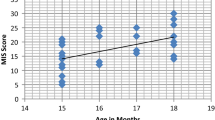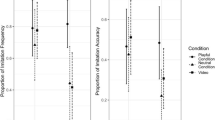Abstract
Two studies investigated the nature of motor imitation in young children with autism. Study 1 compared different types of motor imitation in 18 autistic children, 18 children with developmental delay, and 18 normally developing children. Results revealed weaker imitation skills for the autistic group, though all groups demonstrated a similar pattern of performance across different imitation domains. Imitation of body movements was more difficult than imitation of actions with objects, and imitation of nonmeaningful actions was more difficult than imitation of meaningful actions. Study 2 investigated concurrent and predictive relations between imitation and other developmental skills within a sample of 26 two-year-old children with autism. Results suggested that imitation of body movements and imitation of actions with objects represent independent dimensions. Imitation of body movements was concurrently and predictively associated with expressive language skills, and imitation of actions with objects was concurrently associated with play skills. Improvements in both motor imitation domains occurred over a 1-year period.
Similar content being viewed by others
REFERENCES
Abrahamsen, E., & Mitchell, J. (1990). Communication and sensorimotor functioning in children with autism. Journal of Autism and Developmental Disorders, 20, 75–85.
Abravanel, E., Levan-Goldschmidt, E., & Stevenson, M. (1976). Action imitation: The early phase of infancy. Child Development, 47, 1032–1044.
American Psychiatric Association. (1987). Diagnostic and statistical manual of mental disorders (3rd ed., rev.). Washington, DC: Author.
American Psychiatric Association. (1994). Diagnostic and statistical manual of mental disorders (4th ed.). Washington, DC: Author.
Bates, E., Benigni, L., Bretherton, I., Camaioni, L., & Volterra, V. (1979). The emergence of symbols: Cognition and communication in infancy. New York: Academic Press.
Bayley, N. (1969). Manual for the Bayley Scales of Infant Development. New York: The Psychological Corporation.
Charman, T., & Baron-Cohen, S. (1994). Another look at imitation in autism. Development and Psychopathology, 6, 403–413.
Cicchetti, D. V., & Sparrow, S. A. (1981). Developing criteria for establishing interrater reliability of specific items: Applications to assessment of adaptive behavior. American Journal of Mental Deficiency, 86, 127–137.
Curcio, F. (1978). Sensorimotor functioning and communication in mute autistic children. Journal of Autism and Childhood Schizophrenia, 8, 281–292.
Dawson, G., & Adams, A. (1984). Imitation and social responsiveness in autistic children. Journal of Abnormal Child Psychology, 12, 209–226.
DeMyer, M. K., Alpern, G. D., Barton, S., DeMyer, W. E., Churchill, D. W., Hingtgen, J.N., Bryson, C. Q., Pontius, W., & Kimberlin, C. (1972). Imitation in autistic, early schizophrenic, and nonpsychotic subnormal children. Journal of Autism and Childhood Schizophrenia, 2, 264–287.
Dunst, C.J. (1980). A clinical and educational manual for use with the Uzgiris and Hunt scales. Baltimore: University Park Press.
Eckerman, C., Davis, C., & Didow, S. (1989). Toddlers' emerging ways of achieving social coordinations with a peer. Child Development, 60, 440–453.
Fenson, L., Dale, P. S., Reznick, J. S., Thal, D., Bates, B., Hartung, J. P., Pethick, S., & Reilly, J. S. (1993). MacArthur Communicative Development Inventories: User's guide and technical manual. San Diego, CA: Singular Publishing Group.
Fewell, R. (1991). Play Assessment Scale (5th revision). Unpublished manuscript, University of Miami School of Medicine.
Gardner, M. F. (1990). Expressive One-Word Picture Vocabulary—Revised. Novato, CA: Academic Therapy Publications.
Garfin, D. G., McCallon, D., & Cox, R. (1988). Validity and reliability of the Childhood Autism Rating Scale with autistic adolescents. Journal of Autism and Developmental Disorders, 18, 367–378.
Hammes, J. G. W., & Langdell, T. (1981). Precursors of symbol formation and childhood autism. Journal of Autism and Developmental Disorders, 11, 331–346.
Hedrick, D. L., Prather, E. M., & Tobin, A. R. (1984). Sequenced Inventory of Communication Development—Revised Edition. Seattle: University of Washington Press.
Hertzig, M., Snow, M., & Sherman, M. (1989). Affect and cognition in autism. Journal of the American Academy of Child and Adolescent Psychiatry, 28, 195–199.
Jones, V., & Prior, M. (1985). Motor imitation abilities and neurological signs in autistic children. Journal of Autism and Developmental Disorders, 15, 37–46.
Killen, M., & Uzgiris, I. C. (1981). Imitation of actions with objects: The role of social meaning. The Journal of Genetic Psychology, 138, 219–229.
Lord, C., & Schopler, E. (1989). The role of age at assessment, developmental level, and test in the stability of intelligence scores in young autistic children. Journal of Autism and Developmental Disorders, 19, 483–499.
Loveland, K., Tunali-Kotoski, B., Pearson, D., Brelsford, K., Ortegon, J., & Chen, R. (1994). Imitation and expression of facial affect in autism. Development and Psychopathology, 6, 433–444.
Masur, E. F. (1993). Transitions in representational ability: Infants' verbal, vocal, and action imitation during the second year. Merrill-Palmer Quarterly, 39, 437–456.
Masur, E. F., & Ritz, E. (1984). Patterns of gestural, vocal, and verbal imitation performance in infancy. Merrill-Palmer Quarterly, 30, 369–392.
McCabe, M., & Uzgiris, I. C. (1983). Effects of model and action on imitation in infancy. Merrill-Palmer Quarterly, 29, 69–82.
McCall, R., Parke, R., & Kavanaugh, R. (1977). Imitation of live and televised models by children one to three years of age. Monographs of the Society for Research in Child Development 42 (5, Serial No. 173).
Meltzoff, A., & Gopnik, A. (1993). The role of imitation in understanding persons and developing a theory of mind. In S. Baron-Cohen, H. Tager-Flusberg, & D. J. Cohen (Eds.), Understanding other minds: Perspectives from autism (pp. 335–366). Oxford, England: Oxford University Press.
Meltzoff, A., & Moore, M. K. (1983b). Newborn infants imitate adult facial gestures. Child Development, 54, 702–709.
Meltzoff, A., & Moore, M. K. (1983a). The origin of imitation in infancy: Paradigm, phenomena, and theories. Advances in Infancy Research, 2, 265–301.
Morgan, S., Cutrer, P., Coplin, J., & Rodrigue, J. (1989). Do autistic children differ from retarded and normal children in Piagetian sensorimotor functioning? Journal of Child Psychology and Psychiatry, 30, 857–864.
Ohta, M. (1987). Cognitive disorders of infantile autism: A study employing the WISC, spatial relationship conceptualization, and gestures imitations. Journal of Autism and Developmental Disorders, 17, 45–62.
Pawlby, S. J. (1977). Imitative interaction. In H. R. Schaffer (Ed.), Studies in mother-infant interaction (pp. 203–224). New York: Academic Press.
Piaget, J. (1962). Play, dreams, and imitation in childhood. New York: Norton.
Reynell, J. K., & Gruber, C. P. (1990). Reynell Developmental Language Scales. Los Angeles: Western Psychological Services.
Riguet, C., Taylor, N., Benaroya, S., & Klein, L. (1981). Symbolic play in autistic, Down's, and normal children of equivalent mental age. Journal of Autism and Developmental Disorders, 11, 439–448.
Rogdon, M. M., & Kurdek, L. (1977). Vocal and gestural imitation in 8-, 14-, and 20-month old children. The Journal of Genetic Psychology, 131, 115–123.
Rogers, S. J., & Pennington, B. F. (1991). A theoretical approach to the deficits in infantile autism. Development and Psychopathology, 3, 137–162.
Rutter, M. (1978). Diagnosis and definition of childhood autism. Journal of Autism and Developmental Disorders, 8, 139–161.
Schopler, E., Reichler, R. J., & Renner, B. R. (1988). The Childhood Autism Rating Scale. Los Angeles: Western Psychological Services.
Sigman, M., & Ungerer, J. A. (1984). Cognitive and language skills in autistic, mentally retarded, and normal children. Developmental Psychology, 20, 293–302.
Smith, I. M., & Bryson, S. E. (1994). Imitation and action in autism: A critical review. Psychological Bulletin, 116, 259–273.
Snow, C. E. (1989). Imitativeness: A trait or a skill? In G. E. Speidel & K. E. Nelson (Eds.), The many faces of imitation in language learning (pp. 73–90). New York: Springer-Verlag.
Stone, W. L., Lemanek, K. L., Fishel, P. T., Fernandez, M. C, & Altemeier, W. A. (1990). Play and imitation skills in the diagnosis of autism in young children. Pediatrics, 86, 267–272.
The Psychological Corporation (1993). Bayley Scales of Infant Development Manual (2nd. ed., rev.). San Antonio: Author.
Uzgiris, I. C. (1981). Two functions of imitation during infancy. International Journal of Behavioral Development, 4, 1–12.
Uzgiris, I. C., & Hunt, J. M. (1975). Assessment in infancy: Ordinal scales of psychological development. Urbana: University of Illinois Press.
Yando, R., Seitz, V., & Zigler, E. (1978). Imitation: A developmental perspective. Hillsdale, NJ: Erlbaum.
Author information
Authors and Affiliations
Rights and permissions
About this article
Cite this article
Stone, W.L., Ousley, O.Y. & Littleford, C.D. Motor Imitation in Young Children with Autism: What's the Object?. J Abnorm Child Psychol 25, 475–485 (1997). https://doi.org/10.1023/A:1022685731726
Issue Date:
DOI: https://doi.org/10.1023/A:1022685731726




